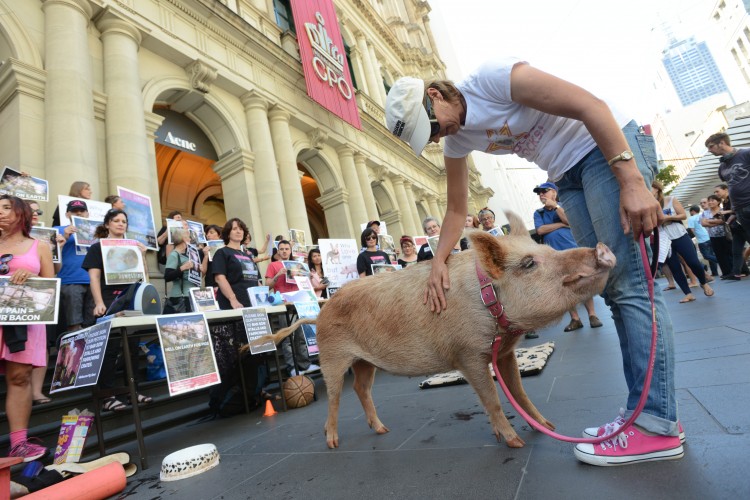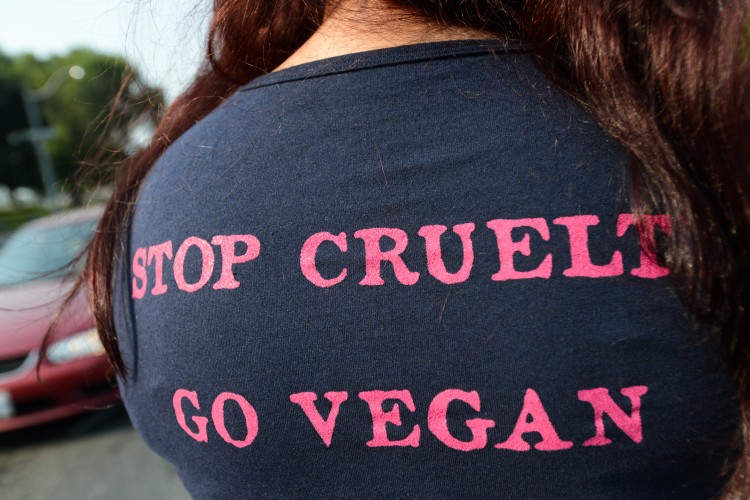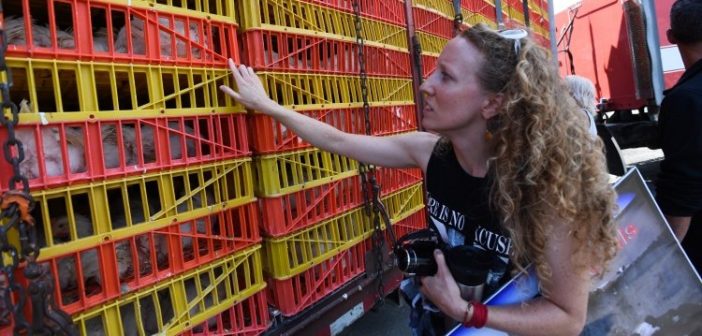Whether you are new to animal advocacy or a seasoned animal activist, it’s important that your advocacy is as effective as possible. Since we all have time constraints, it’s critical that the time you give to activism is as productive as possible at reducing the suffering and misery of animals. Some advocacy methods are more effective when done in organized groups, and others are fine to do independently, so you will want to consider which activities are best suited for you, your skills, and the time you have available.
First you want to consider what types of animals you want to help: companion animals, farmed animals, wild animals, animals used in scientific research, animals used in entertainment, or maybe you want to address all the areas where animals are exploited and mistreated. Animal Charity Evaluators (ACE) suggests if your goal is to do the greatest good for animals, then focusing on farm animal will ensure the greatest potential gains per hour spent. In addition, because typically low donations are given to farm animal charities, public outreach for farm animals is an especially effective way to help the largest group of animals.
Today animal advocates are up against big corporations, big money, and big media, so now more than ever animals need your help. Remember, it’s individuals who can make the greatest difference in changing the world, so your actions do matter and they will make a difference in reducing suffering. For more information, here is a good list of books on animal advocacy.

Effective Methods of Animal Advocacy
Here are some of the most effective methods of advocating for animals. They are ranked alphabetically, not in any particular order of impact. Each of these strategies are considered highly effective and can be combined with other methods for greater impact. Choose the ones that work best for you and your cause.
Boycotts
Historically, boycotts have been extremely effective in bringing about social change. Impacting a business’s bottom line gets their attention. Every time you go shopping you are essentially voting with your pocketbook. Boycotts have been very effective at reducing cruelty to animals, including getting pet stores to stop selling puppy mill dogs, getting retail stores to stop selling fur products, and influencing clothing brands to stop using fur.
Boycotts are usually organized and involve a clear set of demands that indicate the circumstances under which the boycott would end. They can be conducted by a group of individuals or through an organization that refuses to buy certain products or do business with certain companies in protest of their practices.
Changing your diet
One of the most effective ways you can help the largest number of animals today is by transitioning to a vegan diet. Not purchasing animal products directly reduces animals’ suffering and exploitation. Becoming a vegetarian is a step in the right direction, but still exploits and causes suffering for dairy cows, goats and egg-laying hens. Remember, all living creatures deserve to live without having pain and suffering inflicted on them every day of their lives. They deserve the freedom to exhibit their natural behaviors and not to be slaughtered at a young age. Learn more about veganism here.

Demonstrations
Demonstrations work well to bring greater awareness to the general public about a particular issue. This method is a good opportunity to educate, hand out information, and gather signatures for petitions. Protests work to publicize when a business or an organization is guilty of animal cruelty, and they can attract media attention for greater exposure. Demonstrations can range from a small group of individuals holding signs in front of a business to a larger more organized protest. Remember when protesting not to offend or insult the people that you are seeking to gain support from.
Donating
Animal protection organizations need your financial support! Most rely 100 percent on donations. If you want to be most effective, identify an organization to donate to, and sign up for a monthly automatic payment plan. That way they can count on you giving every month and plan their campaigns more effectively. Double the power of your donation and give during a matching gift campaign. Matching campaigns can make a significant impact for charities.
Email and letter campaigns
Joining email campaigns is an easy way to really impact animals. These campaigns are usually orchestrated through animal welfare organizations (often called “Action Alerts”) and involve pre-written emails that protest injustice to animals. Addresses are usually provided, and all you have to do is personalize the pre-written email and click send.
Letters are a highly effective and personal way to get your message across to decision makers in government, industry and the media. You can participate in coordinated campaigns by nonprofits or write and send your own personalized letter that addresses your animal welfare concern. Letters can be sent to government officials, the editor of a local or national newspaper, or any pertinent media publication.
Often non-personalized emails or letters are not counted or accepted, and can get disqualified, so be sure to take a little time to make your message unique to you, even if it is very short. You can even just change the headline and first couple sentences to tweak the message. Always be polite and civil in your messages. Campaign in World Farming offers some great tips for effective letter writing.

Everyday actions
You can be an effective animal advocate everyday, wherever you go, by wearing T-shirts, pins or adding a bumper sticker to your car. A variety of animal welfare and vegan organizations offer great T-shirts and sweatshirts for sale with good graphics and messages. These can be good conversation starters wherever you go. To be even more effective, carry literature with you so you can follow up a good conversation with some information that the person can read later.
Humane education
Humane education requires teaching and public speaking skills and experience. If you have the skills, you can contact teachers to speak in their classroom or speak at organized events sponsored by an animal protection organization. There are many resources for teaching humane education and humane living to a variety of audiences. There are also prepared lesson plans, activities and resources already available for teaching people of all ages. Some organizations that provide resources for teaching humane education include Institute for Humane Education, The Parent Tool Kit, The Empathy Connection (for parents of children), American Humane’s Educator Resources, and Ethical Choices Program.
Leafleting
Leafleting is considered a highly effective, cost-effective and easy method of outreach, particularly for farm animal and vegan/vegetarian literature. Leafleting can be done alone or in groups, on sidewalks, college campuses, shopping centers, transit bus terminals and stations, in front of subway stations, or in front of big box stores or grocery stores. You can get involved with a leafleting campaign by contacting a charity organization that offers leaflets and ordering your own to distribute independently, or work with an organized group to distribute them. Nonprofits that actively leaflet all over the United States are Vegan Outreach, FARM-USA, Mercy for Animals and The Humane League. The Vegan Outreach “Adopt a College” website is a valuable source of information if you’re interested in leafleting on college campuses, which are considered a high impact target. See Vegan Outreach’s “Tips” page to find great advice on how to be more effective with leafleting.

Lobbying politicians
Many animal welfare organizations are working hard on Capitol Hill to write bills, find co-sponsors for bills, get specific legislation passed, and explain how they think officials should vote and why specific animal welfare legislation would benefit animals. These organizations reach out to members to invite them to sign a petition, send a letter, or make a phone call to make their efforts more successful and influential. If you want to get more educated about how your legislators vote on animal issues, and advocate for animals this way, see Humane Education’s page “Get Politically Educated.”
Petitions
Online petitions do work! Petitions are often orchestrated efforts by animal welfare nonprofit groups. There have been countless successes where petitions have worked as the primary method of animal advocacy, or in conjunction with direct outreach. The key is to add your personal comment in the comment section and don’t remain anonymous! Be aware that many legislators will not count anonymous signatures. Sometimes petitions are tossed out altogether due to too many anonymous signatures.
Some of the best legitimate animal welfare petition sites are Change.org, Causes.com, Avaaz.org, Care2 and PETA. Be careful of petition sites that have been called into question, such as Petitionhub, Yousignanimals.org, Yousign.org and others. Make sure that the petition is being sent to a legitimate person of influence.
Phone campaigns
You can join one of the many coordinated phone campaigns sponsored by animal welfare organizations, or independently call companies to protest against animal cruelty by calling their customer service line. Campaigns may be coordinated by organizations that will provide information about the issue and request that you make a short, polite phone call to your state or federal elected officials. They often provide the telephone numbers to the House or Senate switchboard, and you only need to know the name of your elected officials. The organization will often provide you with a short script of what to say, making the call easier.
Share on social media
Social media is a powerful tool for influencing and sharing. Spread the word about helping animals by sharing videos, images and information on Twitter, Facebook, Instagram, Pinterest and Google Plus accounts. Ask friends and family to share on their accounts as well.
Good luck! The animals need you!
This article was originally published on the Humane Decisions website.
Featured image: an activist looks into a transport truck of chickens at a Toronto Chicken Save vigil. Image credit Jo-Anne McArthur / We Animals.





